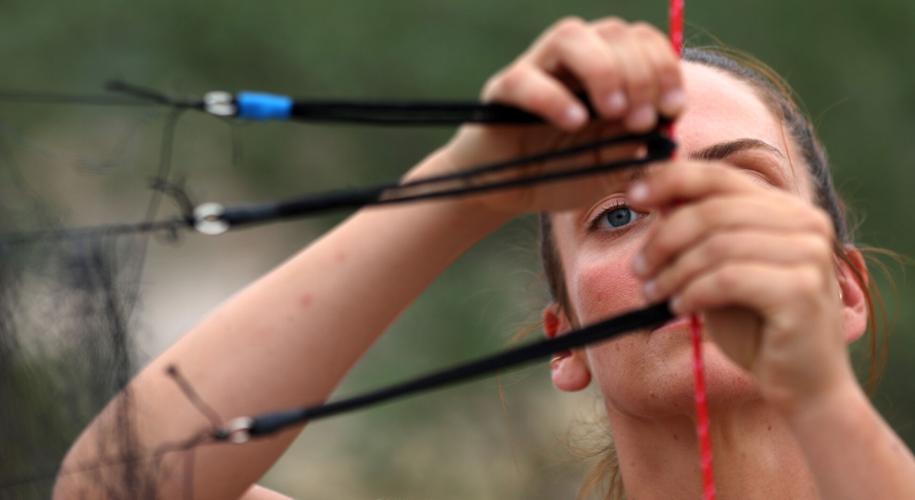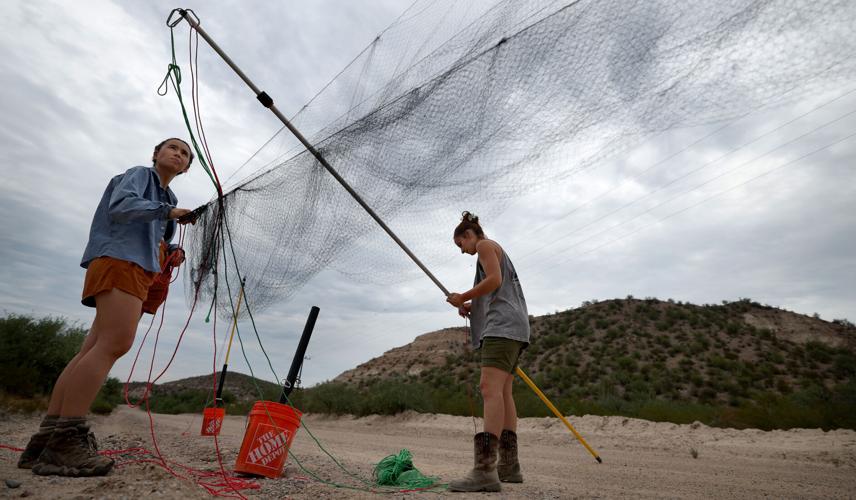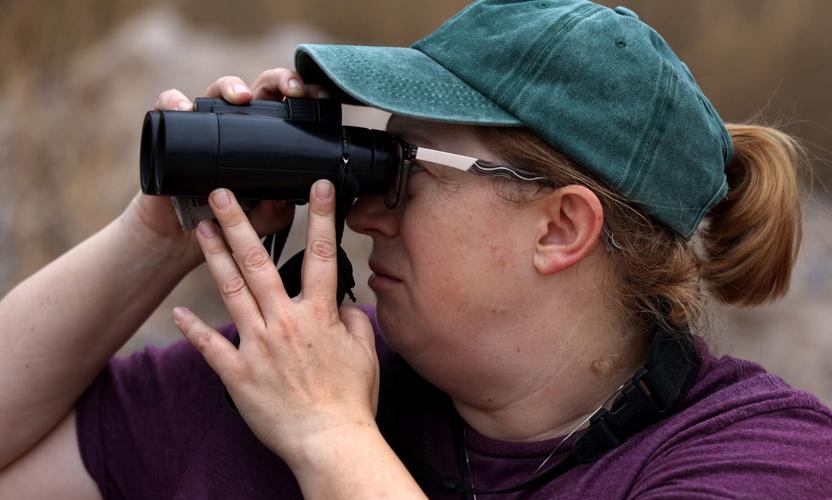A small, iridescent, purple-tinged bird darted from Joe Siegrist’s just-unclasped hands, and quickly flew out of human view.
“Ooh!” an onlooker blurted.
Siegrist, head of a national purple martin conservation group, launched the latest installment Tuesday evening of a prolonged scientific effort to learn just how unique and imperiled is Southern Arizona’s treasured but not well understood purple martin population.
His release of the adult male martin took place on a dirt road paralleling the San Pedro River southeast of Mammoth, a nearly a 90-minute drive northeast of Tucson. Siegrist and other researchers and conservationists had just attached to the bird, a second-year male, a tiny, satellite transmitting device they hope will pinpoint where this bird spends the winter.
That’s one of many scientific steps they say are needed to determine if purple martins living in the desert Southwest are a separate species from two other distinct and much more common martin populations.
One, by far the largest in numbers, lives in the eastern U.S. The other population lives along the West Coast and in some inland mountain areas including northern Arizona. Right now, all three are known as subspecies.
A major reason the researchers are interested is that they see the martins here as vulnerable because their saguaro hosts are vulnerable, probably more so than they’ve been for a long time, due at least in part to human-caused climate change.
Saguaros have been burned in a growing number of Arizona wildfires since 2000 — wildfires sparked by the increasing presence of invasive, non-native grasses. Saguaros in the Phoenix and Tucson areas have also been found to have died or had arms fall off during extreme heat waves in 2020 and 2023.
In some areas of the Sonoran Desert, most notably at Saguaro National Park, saguaro reproduction, called recruitment by researchers, has dropped considerably since the 1940s, a phenomenon possibly linked to human-caused warming, drought and other climate changes.
Plus, 1,200 saguaros blew down during a summer 2023 monsoon-driven windstorm at Saguaro National Park-West. All three of these threats have been either directly linked to climate change or are at least potentially caused by human-induced warming.
But the martins haven’t been studied that much here. So researchers say they need to learn more about them. Depending on what the researchers learn, one possibility could be to try to get the desert martins federally protected as an endangered or threatened species.
“This is the least studied of the three subspecies,” said Jennie MacFarland, a Tucson Audubon Society bird conservation biologist, of the desert-based martins.
The desert martins, unlike the eastern birds that build their nests in peoples’ nest boxes near houses, nest almost exclusively in saguaro cacti cavities in Arizona and northern Sonora that were first drilled by woodpeckers. They also nest in cardon cacti in Baja California. Tucson Audubon says it has mapped martin nest locations in more than 200 saguaros in Southern Arizona.
But unlike the eastern purple martins, whose behavior and wintering grounds have been heavily tracked for years, very little is known about where the desert martins winter, other than it’s well known that all three martin subspecies winter in Brazil.
The concern is that the birds are vulnerable there, too, from the buildup of toxic mercury in the Amazon region.
There also are no population trend estimates available to tell if desert martins' numbers are declining. Nationally, several birding groups have said purple martins in general are declining. In 2022, Smithsonian Magazine pegged the rate of decline nationally at almost 1% a year over the past five decades.
“You can’t protect their wintering grounds until you find out where they go,” said Victoria Wiley, a Northern Arizona University PhD student who is working on the martin research effort here under a National Science Foundation fellowship.
One reason the desert birds have been studied so little is that they nest high up in saguaros, said Siegrist, president of the 5,000-member Purple Martin Conservation Association.
“You can’t climb into a saguaro to look into the hole,” Siegrist said. “You can’t simply reach in and capture them like you can with their eastern counterparts who live in bird houses.”
Another problem with studying the desert birds is they’re far more dispersed than eastern martins that nest in peoples’ yards, MacFarland said.
“They have a much smaller breeding range. But they are more spread out in that good saguaro habitat or the cardon Sonoran habitat in Baja,” MacFarland said. “They’re using habitat that is totally remote. It’s not near people a lot.”
Federal protection possible
Tuesday shortly after 6 p.m., about 200 martins sat on a telephone line across the dirt road where the researchers set up nylon mist netting in hopes the birds would fly in. The net was close to 40 feet long and about 12 feet high.
The adult male and female martins alternated on the wire, with younger birds mixed in. The brightly colored adult males were dark blue to purple colored, while females and immature birds were lighter colored, with gray on the head and chest and white on the lower belly.
Until they settled in for the evening on the phone wire, the birds drifted back and forth from there to the west to a large — 90,000 square feet — pond, owned by the BHP mining company, and adjoining the Lower San Pedro River to its west.
The birds were foraging in both places for insects, their favorites being dragonflies and damselflies, MacFarland said. The San Pedro, which flows on and off at various times of the year, was flowing in one section about one mile behind the pond, she said.
“They’re very social, but they’re shy when you come near the saguaros” where they nest, she said.
To the east of the phone wire, some saguaros dotted a set of rolling hills. MacFarland said the cacti were far more common in areas behind the hills.
To try to lure birds into the netting, Siegrist repeatedly slapped his hands together.
As the birds appeared to be flying closer to the net, he called them aerial insectivores — “they fly around to eat insects and have babies,” he said.
“They have good visual acuity. They’re good at spying flying insects. You can imagine them flying in areas at high speeds and getting a bug,” said Siegrist.
His group, based in Erie, Pennsylvania, specializes in both researching and conducting public education about purple martins, he said.
Depending on how the current research turns out in deciding on the bird’s population size, genetics and risks, “advocacy for listing (as an endangered or threatened species) may be in the future,” he said.
“We do the research. We potentially make a case and we fight for it,” he said.
Birds’ biology nearly unknown
NAU student Victoria Wiley started working on the martin project in 2022, when she returned to NAU as a doctoral student to study birds. She’d previously earned a bachelor’s degree there. She decided to return to study under Prof. Loren Buck, who has been conducting purple martin research since 2016.
A biological sciences professor, Buck says on his website that he is “driven” by questions of what he calls “organismo physiology,” or adaptation of animals to extreme environments and their responses to changing environments. He was looking for students to help him conduct martin research out of his laboratory.
In 2022, Wiley, Siegrist, MacFarland and other researchers were able to place tracking devices known as geolocators on 8 purple martins they captured near Sahuarita. They were all captured in what Wiley calls a “sweet spot,” a group of saguaros hosting four pairs of martins living about 1.3 miles west of the area’s pecan groves, lying south of the town and east of Interstate 19.
A year later, the researchers recovered a geolocator from one of those birds, an adult male. The devices measure light levels at sunrise and sunset hours to determine where the birds are flying. But the birds have to be recaptured for researchers to access the data on these devices.
The recovered geolocator’s data showed the bird had wintered in northeast Brazil, in the state of Maranhao, somewhere between 3,000 and 4,000 miles from Tucson. It was a place where no purple martins had previously been recorded as migrating to, Buck said.
“That was a pretty good indication they don’t share overwintering grounds” with Eastern purple martins, Buck said.
The researchers are trying to learn where the desert martins are going to understand the threats to their wintering grounds, Wiley said.
“If they are going to different places from other (purple martin) subspecies, they wouldn’t have an opportunity to breed,” she said.
But as for now, “we only have one data point,” Siegrist said. “We can’t say that’s where they all go.”
This year, the researchers are trying to attach a different kind of transmitter, one that doesn’t have to be recovered for them to access its data. These tags — about the size of a thumbnail — are solar-powered, and send signals to what’s known as an Argos satellite system.
A constellation of these satellites is orbiting the earth, and when a tag detects a satellite is overhead, it sends out a signal identifying that animal — a signal that researchers can later pick up from the satellite via a private website.
But after they put a transmitter on the one bird on Tuesday, the next three evenings brought monsoon storms to the San Pedro area. Only a few birds showed up each night and no tags were attached to any. The researchers have a permit to attach the tags that lasts through Tuesday.
Beyond establishing the desert bird’s wintering grounds, the researchers will also try to determine through DNA analyses if this bird is genetically distinct from other martin populations, said Wiley. They’ll also try to determine if it has a distinct song, shape and colorations from other martins.
It’s already known that the desert martins are shorter, perhaps 15% shorter, than other martin subspecies, Wiley said. Considering all three subspecies, the martin averages about 7.5 inches long, Siegrist said.
With the genetics, the researchers have already extracted DNA from the birds’ feathers. They have sequenced the genomes of all three martin subspecies — a laboratory method used to determine the entire genetic makeup of a specific organism.
This month, the researchers will work at comparing the different subspecies’ data through bioinformatics, the process of taking a large dataset and making sense of the data for practical applications, Wiley said.
“It’s important to note that this research does not have any expectations either way on the outcome,” Siegrist said. “Flatly, these desert martins’ biology is almost completely unknown.
“What we’re doing is to learn as much as we can using modern technologies. If we don’t understand them, there is no way to conserve them.”
A ‘unique desert bird species’
The threats to saguaros from wildfires were spelled out in a recent report, published by the Southwest Fire Science Consortium with funding from the Arizona Wildfire Initiative, two efforts based at Northern Arizona University aimed at improving wildfire prevention, management and recovery. The report lists a confluence of human-caused factors for an increase in wildfires. It said they threaten to transform Sonoran Desert habitat into a fire-prone grassland of non-native plants.
Ben Wilder, one of the report’s co-authors, said, “I don’t have my finger 100% on the pulse” of the saguaro’s population status across its entire Sonoran Desert habitat. “Our data points are very few,” said Wilder, a former director of the Desert Research Laboratory on Tumamoc Hill.
At a spring 2023 conference in Tucson, a group of saguaro researchers laid out an ambitious blueprint to conduct the largest study ever of saguaros to assess their status in the face of mounting threats from climate change. They will try to determine how the saguaro is faring across its range, stretching from southern Sonora up north almost to Interstate 40 in northwestern Arizona.
Wilder said he agreed with those researchers’ conclusion that there currently is no species-wide assessment. But if you add up all the various pressures building on the saguaro population — wildfires, lack of recruitment, heat, drought and occasional blowdowns — “that’s a lot of negative pressure on the saguaros,” he said.
He said he’s glad to learn of the ongoing purple martin study, having observed the birds “anecdotally” from here to the cardon cactus forests of Sonora and Baja California.
“I’ve identified them as a really unique desert bird species. The elevation of their population in the desert (to a distinct species) is important. Their connection to saguaros is critical, bringing more recognition, more science, and hopefully more conservation,” he said.
As for the threats to the birds from mercury, Wiley and Bock say they’re concerned because mercury that settles in the water in Brazil first bioaccumulates in microbes and bacteria. Then it builds up first in insect larvae, then in insects that the birds eat.
“It concentrates in the food chain” there, Wiley said.
Mercury occurs naturally in the Amazon basin’s soils from the uplifting of the Andes, Bock said. But human activities are upping the concentrations in the waters where insects and birds live, he said.
One factor increasing mercury levels in the water is the presence of gold mines “dumping 7,000 tons of mercury in the Amazon Basin” annually, he said.
Another factor is the presence of about 200 hydroelectric dams in the region, he said. The dams slow the basin’s rivers’ flow, allowing elemental mercury that forms naturally to settle to river bottoms and be converted by microbes to much more toxic methyl mercury that the birds ultimately consume, Bock said.
Protection could be research ‘byproduct’
Siegrist, who has been involved with the desert martin project from the start, said that getting them federally protected is not a stated goal of the research effort but “it’s a potential byproduct of the research."
“Granted, that particular outcome potentially could afford additional protections that (the birds) do not currently experience.”
While researchers haven’t documented a decline in the Arizona bird’s population, that doesn’t disqualify it from being listed as endangered or threatened, said Steve Spangle, the now-retired, former head of the U.S. Fish and Wildlife Service’s Arizona ecological services office.
Population decline is not one of the five factors that the wildlife service legally must consider in deciding whether to protect a species, he said.
One factor relevant to the martin’s case is that the federal Endangered Species Act requires the wildlife service to consider “the present or threatened destruction, modification, or curtailment of its habitat or range.”
While saguaro populations also aren’t known to be in decline, documented threats to its habitat mean “it certainly is a possibility” that the Arizona bird could qualify for listing, he said. A population decline could add credence to a claim habitat loss is occurring, he said.
“It’s kind of a ‘how high is up?’” question,” Spangle told the Star. “When you’re looking to list something, considering whether to list something, you have to make a case for it.”
It’s known and well documented that the non-native grasses now invading the Sonoran Desert have caused wildfires to burn hotter, and that the desert is not a fire-adapted ecosystem, he said.
“There’s no formula that says this species is headed for extinction,” Spangle said. “It’s a judgment call. That’s what courts are for.”
Asked how federal protection would benefit the desert martins, MacFarland first replied, “good question.”
Then she said that since one of the main drivers of a possible decline is invasive grasses, a federal listing would probably open up more funding to help control and remove the grass.
“You’d also have to identify critical habitat. That would help keep those critical habitat areas from being converted to urban areas, to businesses,” she said.
As for using a purple martin listing to combat human-caused climate change, MacFarland conceded she doesn’t know how that could work.
“It’s hard for Tucson Audubon to weigh in on something like that. We don’t have a sweeping scale. It may help with larger initiatives that bigger groups and agencies are doing,” she said.
Fighting climate change — “that’s the challenge, isn’t it? That’s what we’re up against. It may take half a century or one century” to fully combat it, Bock said.
But besides creating more pressure to protect desert martin habitat from development, a federal listing could increase pressure on Brazil to try to crack down on gold mining or do something about the Amazon basin dams, he said.
“There can be conservation initiatives on both sides of the border,” he said.








